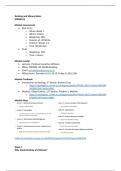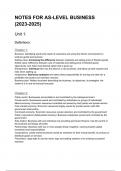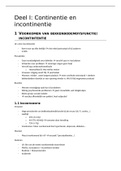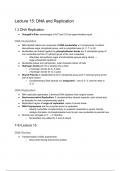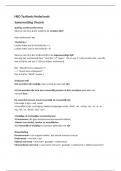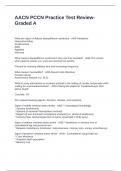MAN3124
Module Assessment
• Mid-Term:
o When: Week 7.
o Where: Online.
o Weighting: 30%.
o Consists of: 20 MCQs.
o Content: Weeks 1-5.
o Time: 50 Minutes.
• Final:
o Weighting: 70%
o Time: 2 Hours.
Module Leader
• Lecturer: Professor Jonathon Williams
• Office: 09MS02, Rik Medlik Building
• Email:
• Office Hours: Thursday 15:15-16:15, Friday 11:00-12:00.
Module Textbook
• Introduction to Banking, 3rd Edition, Barbara Casu
o https://readinglists.surrey.ac.uk/leganto/public/44SUR_INST/citation/909194
9430002346?auth=SAML
• Markets, Global Edition, 13th Edition, Frederic S. Mishkin
o https://readinglists.surrey.ac.uk/leganto/public/44SUR_INST/citation/909194
9430002346?auth=SAML
Module Map
https://surreylearn.surrey.ac.uk/d2l/le/lessons/241376/topics/2667206
Week 1
Why Study Banking and Money?
,Week 1 SBS on Demand
Why Banks are Special
A World Without Banks
• Direct finance prevails and corporations borrow directly from lenders or lenders hold
cash.
• The flow of funds from the household sector to the corporate is likely to be low.
Why?
o Monitoring Costs:
▪ Households must monitor the corporations whose claims they hold.
Since this action is costly (and difficult), little or no monitoring will
occur, which increases the risk of investing in corporate debt and
equity.
o Liquidity Costs:
▪ The relatively long-term nature of corporate securities might prompt
households to hold cash for liquidity reasons (E.g., finance
consumption expenditures).
o Price Risk:
▪ Households are exposed to the risk that price of an asset will be lower
than its purchase price.
Why do Banks Exist?
Banks & ither FIs) have developed because of market failure and asymmetric information.
• Banks are the main source of external funds through what we term ‘indirect finance’,
and they intermediate between lender-savers and borrower-spenders in a process
called financial intermediation.
• Banks bridge the gap between lenders and borrowers who have different
requirements:
o Lenders’ Requirements:
▪ Minimise Risk (default, assets drop in value) and costs; enhance
liquidity (leads to a preference for ST investments over LT).
o Borrowers’ Requirements:
▪ Funds at a particular date, for a specific time, and at lowest possible
cost (explains preference for LT financing over ST).
• Banks reconcile often incompatible needs by offering suppliers of funds safety and
liquidity by using funds deposited to finance loans and investments.
• Banks help to resolve market failures that prevent the efficient functioning of the
financial markets:
o Banks reduce transaction costs particularly search and verification costs.
▪ Searching for counterparties and obtaining information about them;
the costs of negotiating contracts; monitoring borrowers;
enforcement costs.
• And problems relating to Asymmetric Information:
o One party has better information than the counterparty:
▪ Borrower has better information about the risk & returns of
investment than the lender does.
Theories of Financial Intermediation
, 1. Financial Intermediation and Delegated Monitoring:
o Since monitoring credit risk (likelihood that borrowers default) is costly, it is
efficient for lender-savers (depositors) to delegate monitoring to specialist
agents like banks.
o Banks have expertise and economies of scale in processing information on
risks (creditworthiness) of borrowers)- too costly/ difficult for depositors.
o Thus, banks have net cost savings relative to direct finance. This advantage
arises through two channels:
▪ (i) Diversification of the bank’s portfolio across different investment
projects.
▪ (ii) Size: larger banks can achieve bigger economies of scale in
monitoring, which produces greater portfolio diversification.
o Through financial intermediation, depositors ‘delegate’ the monitoring (of
borrowers) role to banks.
o Strong Incentive: Banks must monitor borrowers (behaviour) to make sure
returns are realised:
▪ Banks sit between lenders and borrowers.
▪ But the returns promised to lenders are independent of the returns
received from borrowers.
o Banks’ total lending costs include the following items:
▪ Search Costs:
• Banks must find borrowers.
▪ Evaluation/ Verification Costs:
• Is the borrower suitable?
▪ Monitoring Costs:
• Once the loan has been made.
▪ Enforcement Costs:
• Ensuring compliance with terms of loan.
Who Monitors the Monitor?
There is a particular problem associated with delegated monitoring. Namely, who monitors
the monitor?
• Delegating responsibility to banks raises issues:
o If depositors delegate monitoring to the bank, then depositors should
monitor the bank.
o Outcome: delegation does not remove the need to monitor.
• Depositors and Bank Runs:
o Depositors need to infer the health of a bank by watching the actions of
others.
o Pressure to do this quickly (‘first com first served’) can result in irrational
bank runs.
Theories of Financial Intermediation
2. Information Production:
o Information about possible investment opportunities is not free:
▪ This incentivises agents to produce and sell information.
, ▪ Thus, and if banks did not exist, a costly duplication of information by
multiple agents would occur.
o Banks achieve economies of scale in processing information on borrowers,
which they build up over time via customer relationships.
o Therefore, banks hold an information advantage over lender-savers who are
willing to deposit funds with a bank.
o Why?
▪ The bank directs it resources to the most efficient uses without
depositors incurring information costs.
3. Liquidity Transformation:
o Banks issue secondary claims to lender-savers (Depositors):
▪ Claims often have a superior liquidity compared to direct claims (i.e.,
securities).
o Banks deposits offer low risk and high liquidity to holders:
▪ These liabilities fund riskier assets (loans and securities).
o Banks hold assets & liabilities of different risk & liquidity due to portfolio
diversification:
▪ In contrast, depositors hold relatively undiversified portfolios which
increase risk.
▪ Better diversification, lowers the likelihood banks will default on
meeting deposit obligations.
4. Consumption Smoothing:
o Banks can smooth consumption by providing insurance against shocks to a
consumer’s consumption path.
o How?
▪ Agents have uncertain preferences for their expenditure that creates
demand for liquid assets.
▪ By providing liquid assets via loans, banks help smooth consumption
patterns for agents.
5. Commitment Mechanisms:
o Banks fund illiquid bank assets (loans) mostly through demand deposits:
▪ Deposits are a relatively cheap source of funds for banks.
▪ However, customers have daily requirements for cash and banks must
meet requirements with immediacy.
o Changes in the supply and demand of customer deposits affect a bank’s
financing costs:
▪ The prospect of losing cheap funds creates market discipline.
▪ It commits banks to control risks and behave prudently:
• Typically, by holding sufficient liquidity and capital.
The Role of Banks
What do Banks do and how do they do it?
• In the financial intermediation process, banks raise funds (mostly deposits) from
lenders and lend funds (loans) to borrowers.
o What are the different characteristics of deposits and loans?
▪ Deposits: small-size, low-risk, high-liquidity.
▪ Loans: large size, high-risk, illiquid.

